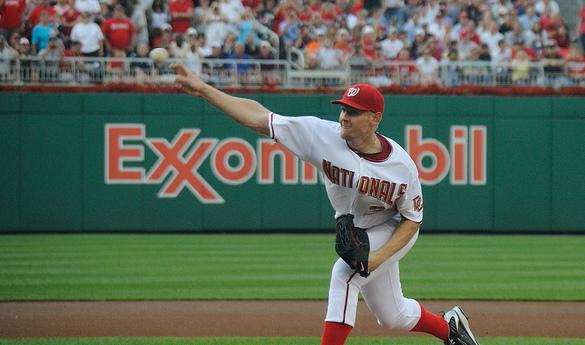COLUMN: Better safe than sorry for Nats ace Strasburg
Every time Stephen Strasburg takes the mound, all eyes are entranced by the young righthander's surgically repaired elbow. Every inning pitched pushes the minute hand on his shutdown clock closer and closer to the hour of his inevitable benching. Like Cinderella at the ball, Strasburg's stroke of midnight is coming and coming fast. With only two to three starts left, Strasburg has become the center of attention in all of baseball. But, shutting him down may be one of the noblest decisions Nationals General Manager Mike Rizzo could make. A general manager looking out for a player's health in a sport where steroids and winning at all cost have been issues for decades.
When Rizzo made a statement that his prized pitcher would be on a 160-180 inning limit, the entire baseball world took his words with a grain of salt. That was back in spring training when the Nationals were coming off an 80-81 2011 campaign and a new sense of optimism buzzing around the ball club. If anyone would have told you that the Nationals would be the best team in the National League in late August and on the cusp of a playoff berth, even the most optimistic fan would have told you that they were at least another year away. The dominance of the pitching staff with the complement of a young roster of homegrown talent and veterans, the Nats took the NL East by storm leading the division for over three months now.
And as the playoffs become a high possibility, the countdown to shutdown begins to creep into the headlights.
But, one thing that people don't realize are the steps that the Nationals organization has gone through to evaluate Strasburg in attempt to protect him and his career longevity. Rizzo with the help of a handful of doctors, including Dr. James Andrews, and Strasburg's surgeon, Dr. Lewis Yocum, made an educated evaluation of Strasburg's elbow and his recovery. I don't know about you but when two of the most well respected athletic surgeons in the country strongly caution overworking a pitcher after having Tommy John surgery in September 2010, I have to trust their judgment on the subject.
Strasburg's herky jerky arm delivery is also a cause for concern for the Nationals and another reason pushing his innings limit over 200 could be detrimental to his progression. The way his arm slot is situated when he plants his left foot to deliver the baseball causes increased stress to the shoulder and rotator cuff. Also, this is Strasburg's first full season in the major leagues with more innings pitched this year (150.1) than the past two seasons combined (92.0). The twenty-three year old has less than two years of major league experience under his belt, coming off Tommy John surgery, and touting a delivery that is a ticking time bomb waiting to explode.
Another reason there has been such uproar about the situation is due to the Nationals success, and in particular Strasburg's notoriety as one of the best young arms in the game.
But as strong as Strasburg has pitched this season, you can make the argument that he hasn't even been the best pitcher in the Nats rotation--in fact the entire Nats rotation has been better than advertised. Jordan Zimmermann, who underwent Tommy John surgery in 2009 and pitched 161.1 precautionary innings last season, has been electric since the All-Star break. Since July 14, he is 4-2 with a 2.42 ERA and 45 strikeouts. He was also the NL Pitcher of the Month in July. With a 9-8 record, 2.63 ERA and 119 strikeouts, Zimmermann has become the mold for how following an innings limit can effectively recover a surgically repaired elbow and ultimately, produce success. Gio Gonzalez has also been worth every prospect that he was traded for in the offseason from the Oakland Athletics. Posting the best record on the team (16-7), he looks prime to have postseason success. Along with fireballers Edwin Jackson and Ross Detwiler, plus the possible call-up of John Lannan, the Nats have tools to make a run in October.
Rizzo has stated time and again of the importance of Strasburg's health and his role as the ace of the pitching staff. He is the future of the Nationals, no question, and should be cared for as the long-term investment that he is.
For example, if you have an antique car worth six figures and you are constantly driving around in it, eventually the car will acquire weather wear and possibly be damaged by an outside source you can't control. I understand that you want to use your investment; otherwise what's the point? But, if you are reckless with your investment and don't take the proper precautions, you are wasting your time. Though the example is somewhat stretched, it has some truth to it. Getting the most out of your investment should be the top priority--and that's what Rizzo and the Nats are doing.
Yes, it sucks that Nats fans won't see their ace toe the rubber in the first playoff game in the nation's capital since 1933. But, if I told you that Strasburg would pitch the playoffs, the Nats make it to the NLCS and lose but he injures his shoulder or elbow and is never the same pitcher he was before, would you take it? I didn't think so. Better safe than sorry.
Nonetheless, won't it be a sight to see a healthy Strasburg in a warm-up pullover watching his team play in a World Series. God, this is a mess!
Pat Carroll is C2M's Sports Editor and writes a weekly sports column for C2M.

